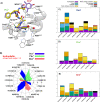Novel Mixed NOP/Opioid Receptor Peptide Agonists
- PMID: 33998786
- PMCID: PMC8279409
- DOI: 10.1021/acs.jmedchem.0c02062
Novel Mixed NOP/Opioid Receptor Peptide Agonists
Abstract
The nociceptin/orphanin FQ (N/OFQ)/N/OFQ receptor (NOP) system controls different biological functions including pain and cough reflex. Mixed NOP/opioid receptor agonists elicit similar effects to strong opioids but with reduced side effects. In this work, 31 peptides with the general sequence [Tyr/Dmt1,Xaa5]N/OFQ(1-13)-NH2 were synthesized and pharmacologically characterized for their action at human recombinant NOP/opioid receptors. The best results in terms of NOP versus mu opioid receptor potency were obtained by substituting both Tyr1 and Thr5 at the N-terminal portion of N/OFQ(1-13)-NH2 with the noncanonical amino acid Dmt. [Dmt1,5]N/OFQ(1-13)-NH2 has been identified as the most potent dual NOP/mu receptor peptide agonist so far described. Experimental data have been complemented by in silico studies to shed light on the molecular mechanisms by which the peptide binds the active form of the mu receptor. Finally, the compound exerted antitussive effects in an in vivo model of cough.
Conflict of interest statement
The authors declare the following competing financial interest(s): S.P., V.A., D.I., C.T., E.M., C.R., D.P., G.C., and R.G. are inventors of the patent application (102020000025972) focused on NOP/mu mixed agonists. G.C. and R.G. are founders of the University of Ferrara spin off company UFPeptides s.r.l., the assignee of such patent application. C.R. is CEO of UFPeptides s.r.l.
Figures





References
-
- Meunier J.-C.; Mollereau C.; Toll L.; Suaudeau C.; Moisand C.; Alvinerie P.; Butour J. L.; Guillemot J. C.; Ferrara P.; Monsarrat B.; Mazarguil H.; Vassart G.; Parmentier M.; Costentin J. Isolation and structure of the endogenous agonist of opioid receptor-like ORL1 receptor. Nature 1995, 377, 532–535. 10.1038/377532a0. - DOI - PubMed
-
- Reinscheid R. K.; Nothacker H. P.; Bourson A.; Ardati A.; Henningsen R. A.; Bunzow J. R.; Grandy D. K.; Langen H.; Monsma F. J. Jr.; Civelli O. Orphanin FQ: a neuropeptide that activates an opioidlike G protein-coupled receptor. Science 1995, 270, 792–794. 10.1126/science.270.5237.792. - DOI - PubMed
Publication types
MeSH terms
Substances
LinkOut - more resources
Full Text Sources
Other Literature Sources
Chemical Information
Research Materials

